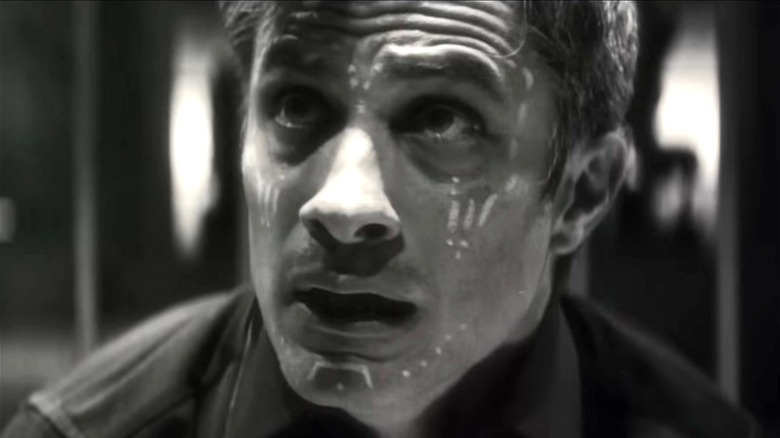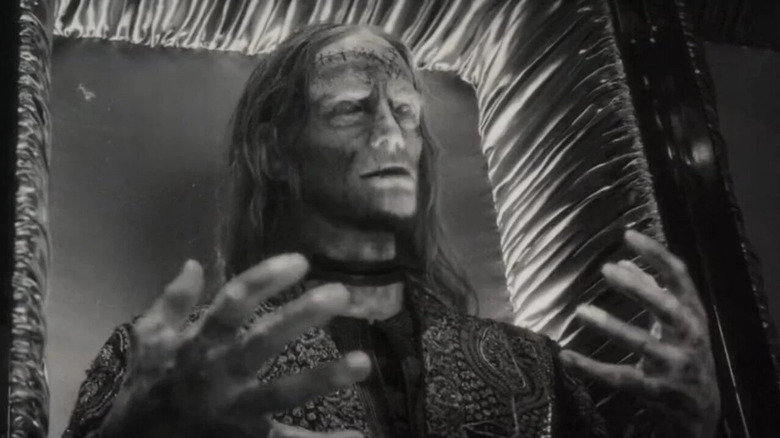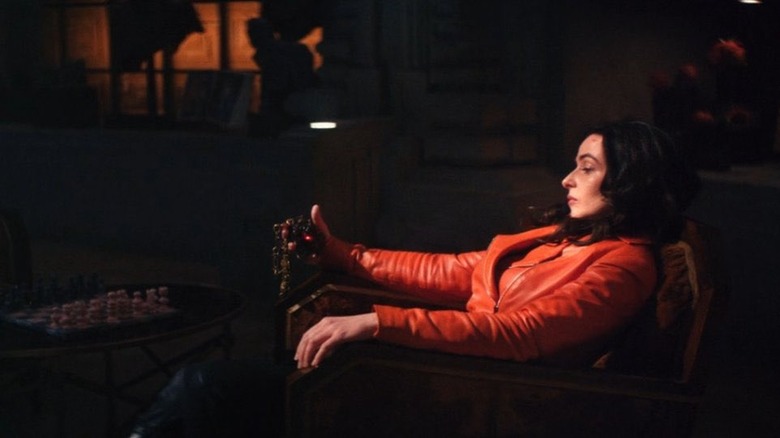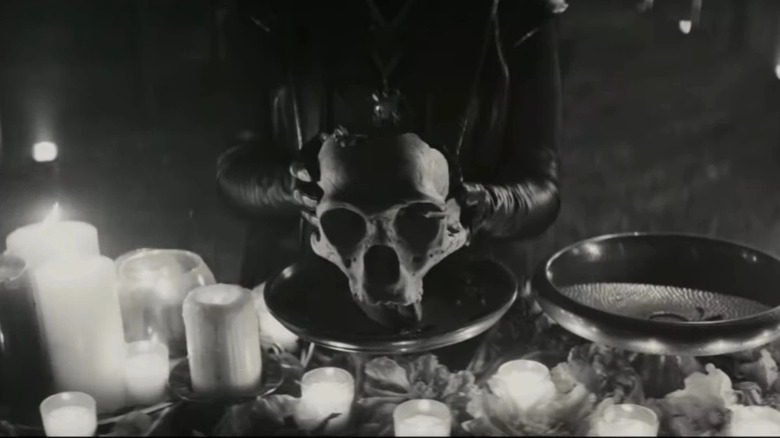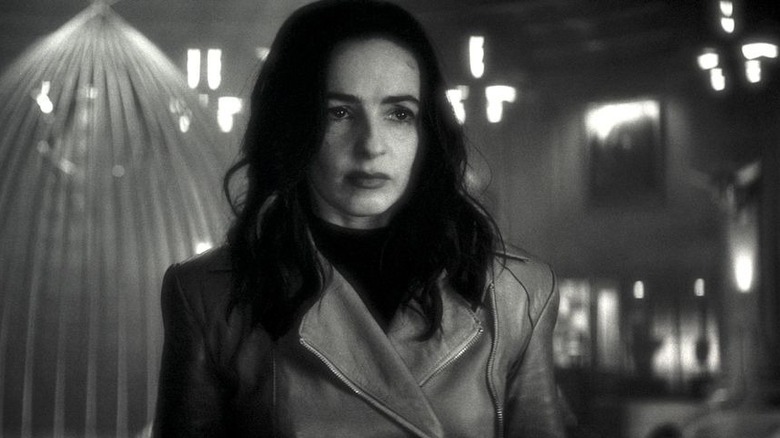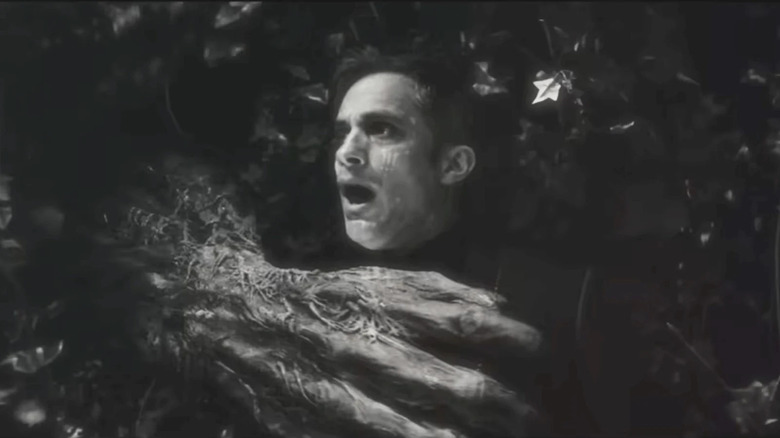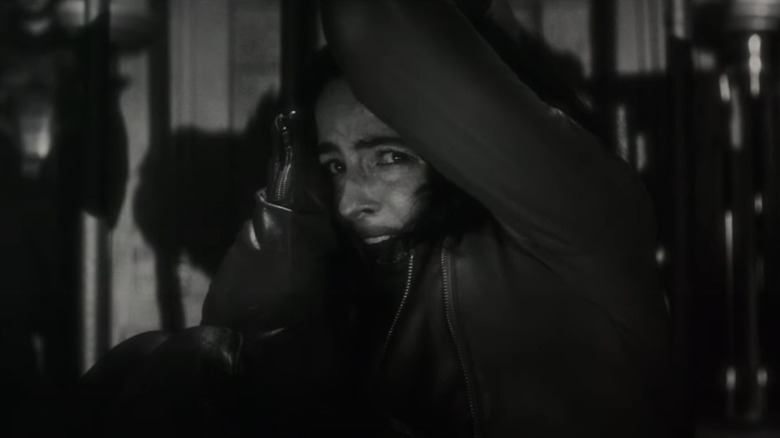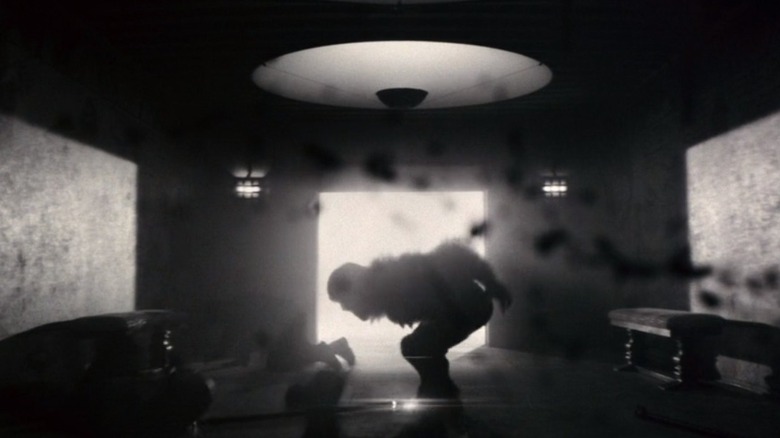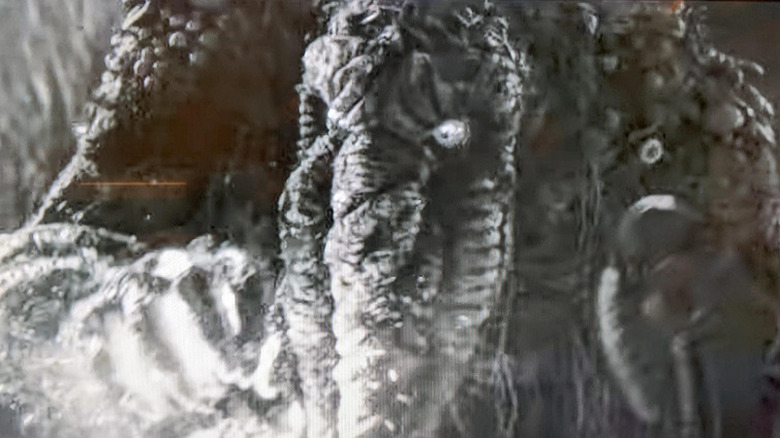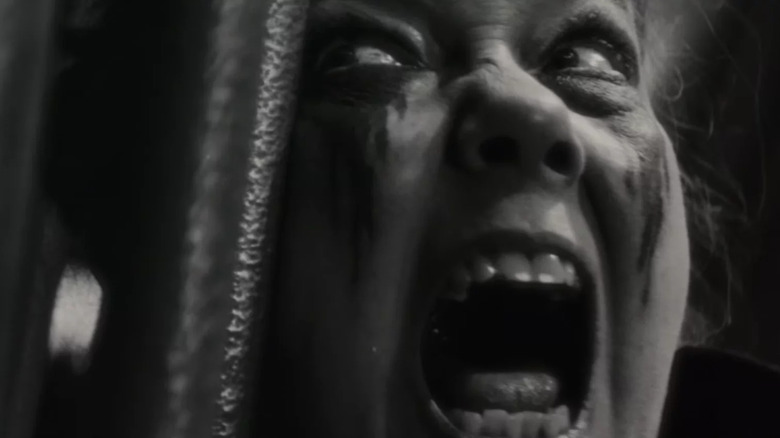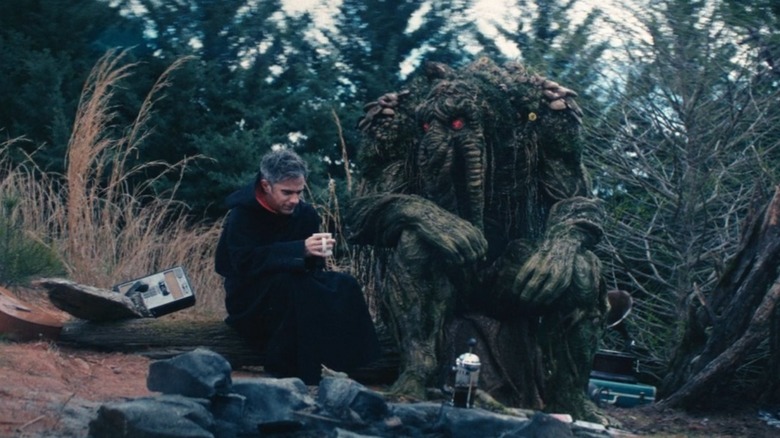The Ending Of Werewolf By Night Explained
Disney+ and Marvel Studios have termed "Werewolf by Night" a special presentation, distinct from the franchise's feature films and limited series. Though the one-off horror throwback definitely ties into the wider MCU, that distinction gives director Michael Giacchino and his team considerable leeway in terms of the special's look, tone, narrative arc, and runtime — it clocks in at an easily digestible 53 minutes.
The character Werewolf by Night was first introduced by Marvel Comics in 1972 in an issue titled "Marvel Spotlight" #2, and many of the monsters and monster hunters in this Halloween mini-movie can also trace their origins back to the pages of comic books. The MCU has been leaning into the horror genre with the darker-than-usual "Doctor Strange in the Multiverse of Madness" sequel plus "Moon Knight" (a foe of Werewolf by Night), Morbius, and the remake of "Blade," so a "Werewolf by Night" entry makes sense at this point in Phase 4.
Above all else, however, "Werewolf by Night" is a loving homage to the horror classics of the '30s, '40s, and '50s. It's shot in black and white with dramatic close-ups and creative cutaways. It utilizes purposefully stagey practical sets, props, and effects. It's equal parts cheesy and scary, which makes it Disney+ worthy and fairly family-friendly, despite the fact that it's one of the most unflinchingly violent Marvel Studios products made to date.
"Werewolf by Night" is an inventive and refreshing tangent that can absolutely be viewed and understood on its own. Still, for those who want to know how it refers back to Marvel and movie monsters' past — and what it might mean to the MCU's future — here's how to interpret the plot twists that lead to the ending.
A secret cabal of monster hunters
In a vintage-y and exposition-heavy opening we learn that in addition to superheroes and supervillains like the Avengers and Thanos there are monsters that lurk in the darkness. Of course, where there are monsters, there are monster hunters who believe it's their noble duty to slaughter them. The Bloodstone family has been in the business of monster hunting for generations, and they're better at it than anybody else because of one particular relic (which we'll get to shortly). This prologue contains a few notable Easter eggs, such as someone resembling the Black Knight who can be seen at a medieval gathering of monster hunters in one illustration.
Ulysses Bloodstone represented the seventh generation of monster hunters and was the most recent patriarch, but our story begins with his funeral. The sketch of his corpse crossfades into a shot of a full moon, which might suggest that a werewolf or even our Werewolf by Night is the one who did him in. In any case, monster hunters from around the globe have arrived at Bloodstone Manor to participate in a ceremonial hunt to determine who will inherit the relic and his position as monster hunter-in-chief. Among them is our protagonist, Jack Russell, who is said to have 100 kills to his name. Also present are hunters named Jovan, Liorn, Azarel, and Barasso. They're joined by Elsa Bloodstone, Ulysses' estranged daughter.
The Bloodstone is the latest powerful Marvel gem
Ulysses Bloodstone's wife at the time of his death was Verussa, a sadistic-seeming woman who takes her role as organizer of the ritualistic hunt extremely seriously. She explains to the competitors that whoever slays the monster and claims the Bloodstone will become its new master. The stone, that initial voiceover tells us, is a supernatural relic and a weapon unlike any other. As Verussa outlines the terms of the hunt — weapons are hidden throughout the manor grounds and it's every hunter for themselves — she mentions that the stone has been affixed to the hide of the monster in question and that it weakens the beast but also makes it angry. Later, we'll see Verussa use the Bloodstone to reveal and repel monsters. She also lets slip that its aspects are strength, protection, and longevity.
For the purposes of "Werewolf by Night," the Bloodstone serves as the MacGuffin that all the players are after, not unlike the Infinity Stones in previous phases of the MCU. Just like the Mind Stone, the Time Stone, and so on, the Bloodstone has its roots in Marvel Comics. It first appeared in a 1975 issue of "Marvel Presents" #1 about Ulysses Bloodstone, where it was deemed the bloodgem and bestowed its possessor with superhuman strength, resilience, and an increased ability to detect monsters. It was eventually split into two, with the larger chunk going to Elsa Bloodstone, who also pops up as a Marvel Comics character, too. Though "Werewolf by Night" is (for now) mostly a standalone property, the Bloodstone could come into play later.
A manor full of references
The deceased Ulysses Bloodstone has invited the world's best monster hunters to Bloodstone Manor with medallions which the hunters exchange for a chance to prove their skill. These hunters, we learn, typically conceal their identities — anonymity is important in their line of work, Jovan explains — but not tonight. As Jack introduces himself to the other monster killers, he steals glances periodically at his surroundings. The hunters themselves are so strange looking, it's hard to tell the taxidermy from the live combatants. Adorning the walls of this Great Hall are busts of "hacked beasties" that Ulysses and his fellow hunters have vanquished over the years.
There are also beasties in the process of being hacked in that opening sequence and on the frescos in the corridors. Viewers can make out Nosferatu, Wendigo, and Sasquatch, all of whom are Marvel Comics characters. Nosferatu intertwines with the Atlantians in the comics, which is interesting considering Atlantis will be featured in "Black Panther: Wakanda Forever." Wendigo comes into contact with Hulk and Wolverine. Again, this is interesting since Hugh Jackman is said to be reprising his role in "Deadpool 3." Sasquatch is shown having crossed paths with Hulk, the X-Men, Loki, Namor, and Super-Skrull.
These monsters are both singular characters and species types, so even if their mounts are displayed at Bloodstone Manor, it's not unreasonable to think they might return to the MCU in some capacity at a later date.
Elsa the outcast
When Verussa learns Elsa has arrived, Ulysses Bloodstone's widow is noticeably upset. From their conversation in a passageway, apart from the rest of the group, we learn that Elsa is Ulysses Bloodstone's daughter by another woman, presumably an earlier wife. She's been away for 20 years and Verussa refers to Elsa as her father's greatest disappointment. She was an even more promising monster-hunting prospect than her father, but Verussa laments that she turned out more like her mother. We can piece together that Ulysses and Elsa's mom either had some sort of falling out or that she died under circumstances that brought the Bloodstone family shame. There's no love lost between Verussa and Elsa's mother — that much is clear.
We can also safely assume that around twenty years ago, Elsa split with her father's monster-hunting methods (or perhaps his motives altogether) to follow in her mom's footsteps. When Verussa doubts she'll be able to claim the stone because of her lack of training, Elsa corrects her. Just because he didn't train her doesn't mean she hasn't been prepared. Indeed, her fighting prowess is plain for all to see when she engages Jovan and Liorn in combat.
Elsa Bloodstone is the preeminent monster hunter in Marvel Comics, but this thematically switched-up rendition gives her a fascinating new path to tread as a disaffected monster hunter and heir to the Bloodstone and Manor.
Jack doesn't want to fight
Anyone who was privy to anything about "Werewolf by Night" knew that Gael García Bernal had been cast in the title role, so the fact that Jack Russell turns out to be Werewolf by Night isn't actually much of a surprise. What is a mystery is why he's there at Bloodstone Manor amongst the monster hunters and whether any of them will uncover his secret identity. There's also the matter of the monster on the loose and what variety of beast it is.
The answer to two of these questions comes in one of the special's best moments, which begins when Jack thinks he hears something near a hedge wall. A split second later, an enormous, monstrous hand reaches out and grabs him by the chest. That hand belongs to Man-Thing (Carey Jones, who also suited up as Black Krssantan), a Marvel Comics swamp creature who first appeared in 1971's "Savage Tales #1."
Man-Thing also goes by the name Ted. In the comics, he's a biochemist named Dr. Ted Sallis who morphs into Man-Thing after injecting himself with super-serum and jumping into the Everglades. Ted happens to be best buds with Jack, who's risking his own hide to get the Bloodstone and break him free. Jack isn't a killer at heart, which is why he avoids fights with Jovan and Elsa. Even though we see Man-Thing crush Jovan's skull, he's acting in self-defense.
Ulysses presumably captured Man-Thing prior to his death and has turned his murder into a group sport. The talking corpse of Ulysses promises the hunters that Man-Thing is a monster unlike anything they've ever seen. One of the strongest bits of this adaption is the exceptional character design of this strange but fascinating Marvel character.
The Bloodstone forces Jack to transform
Jack Russell suffers from lycanthropy — sometimes portrayed as a curse that runs in his family in the comics — a condition that causes him to shapeshift into a werewolf during the full moon. He asks for Elsa's help in springing Ted from the walled garden, but he doesn't disclose this pertinent piece of information. Jack does manage to blast open an escape route for Ted, but when he reaches for the Bloodstone (we don't know whether he intended to steal it or to give it to Elsa), he's blown backward, rejected by it, and left in pain. This gives him away — the others now know he's some type of monster. They trap him in a large cage with Elsa as punishment for their treachery.
At first, Jack tells Elsa not to worry. He's got it all under control. He's come up with systems to mitigate the harm he could cause and promises they work. Plus, he says, there won't be a full moon for five days. Elsa puts two and two together, realizes he's a werewolf, and figures out her stepmother's plan. When Verussa unleashes the power of the Bloodstone on him, it'll change him into whatever else he is, and that monster will, in turn, maul Elsa.
That's precisely what happens — at least to start — but the way it happens is unexpected and spectacular. Marvel certainly has the budget to have shown us Jack's transformation with cutting-edge CGI. Instead, Giacchino relies on old Hollywood smoke and mirrors to do the trick. Jack becomes Werewolf by Night as a shadow superimposed over a terrified Elsa in one of the special's coolest shot compositions.
Werewolf by Night remembers Elsa
Before Verussa exposes Jack to the stone, he tells Elsa to keep eye contact with him and begins to sniff her like a dog. She's confused and slightly put off by this until she guesses what he's actually doing. After he becomes a werewolf, his animal instincts (including his sense of smell) will overtake his human consciousness and Jack won't be in control of his actions anymore. Only by taking note of her scent can he hope to remember that he has some affection for her, which might prevent him from unleashing his full fury on Elsa if he perceives her as an enemy in his altered state. She asks him if this has worked before, to which he answers, "once" — we'd love to see that story!
The Bloodstone does its dark magic and Jack becomes Werewolf by Night, but the cage cannot contain him. He bends and breaks the bars at the top and climbs free, then pounces on the disoriented monster hunters and security guards below. This late in the game, only Azarel, Barasso, Verussa, and Elsa remain. All but Azreal have put on masks and cloaks to begin the ritual of hunting for the prize of the Bloodstone again, and this time, he's the monster they have to defeat. Werewolf makes quick work of the security forces while Elsa takes care of Azarel and Barasso with a sword before subduing her stepmother.
Eventually, it looks like they're the last two left alive, although Jack in his monster form is gravely injured, and Werewolf by Night bursts back into action and pins Elsa to the floor. She pets his cheek, he takes a whiff, then leaves her be.
Man-Thing saves the day
Jack, still in Werewolf mode, wisely heads for the hills. Seconds later, Verussa screams Elsa's name with a voice that could curdle blood, then stands to ready a weapon. She's none too pleased that Elsa has let two monsters get away tonight. "You will now die as you lived, a disgrace to your father's memory and the hallowed Bloodstone name," she screeches.
It looks like Elsa is done for — until Man-Thing crashes down through the glass dome ceiling of the manor's Great Hall. He grabs Verussa by the waist and at his touch she self-immolates. He then tosses her like a rag doll into the coffin of her late husband, Ulysses, whose head comes rolling out onto the floor. Ulysses had his corpse made into a human puppet to perform at his funeral, and the neck appears to have been one of the points of animation.
Since Elsa and Ted have previously made each other's acquaintance, she doesn't fear for her own life. "He went that way," Elsa says through a wry smile as she points Ted in Jack's direction. In the comics, Man-Thing's power is that whatever fears him burns up at his touch. Since the monster hunters are inspired by both bloodlust and fear of the monsters they hunt, this power is a commentary unto itself.
Who were the real monsters?
Though some comic stories have clear-cut heroes and villains, just as often, comic book characters become more pliable than that and can be used for good, bad, or simply as foils for other characters in new and exciting combinations. The MCU's "Werewolf by Night" subverts the idea of a monster hunt and makes the audience root for the monsters and against the hunters. However, that doesn't mean Jack and Ted are good guys, exactly. Jack's reported kill count is around 100 and we see Man-Thing decimate two people on screen. Yet, though they have the claws and fangs of monsters, in this story it's the humans (or some of them) that are out for blood.
The opening tells us that monster hunters take pride in their craft, and Verussa calls hunting a kindness. The hunters clearly see themselves as the protagonists, but anyone who could kill 26, 37, 43, or 57 beings and brag about the number is a monster in a sense. It's worth pointing out that they carry out their calling in disguise and that they're willing to take each other's lives to advance their own careers and win the Bloodstone. These are zealots with narrow worldviews who believe their ends justify any means. From what we see of them, Jack and Ted are just trying to escape persecution. We don't know if we'll see Elsa, Jack, or Ted again, — but if we do, there's no telling where they'll fall on the good-to-evil spectrum. As "Werewolf by Night" illustrates, it's a matter of perspective.
We're not in Kansas anymore
After the mayhem ceases, Elsa sits down with the Bloodstone in hand and Jack joins Ted on a log to discuss what to get for dinner (sushi). Until now, the only thing on screen that has been rendered in color is the Bloodstone. Everything else was depicted in sometimes grainy and low-lit black and white, with cigarette burns in the corner of the screen to make "Werewolf by Night" look as if it's playing on a physical film reel. Slowly, color seeps into Elsa and Bloodstone Manor then Jack, Ted, and the woods in which they hide. At the same time, "Somewhere Over the Rainbow" bellows from an old phonograph.
The more obvious reference here is to the moment in "The Wizard of Oz" when Dorothy's world changes from greyscale to technicolor. Giacchino is sweetly nodding to Hollywood's past with the uber-famous song and the filmmaking technique. However, "Werewolf by Night" is also a tale of the occult, something the MCU has been increasingly interested in. "The Wizard of Oz" is about hunting and killing witches, and witches have been introduced into Marvel Cinematic Universe. "Agatha: Coven of Chaos" is forthcoming, and Wanda's chaos magic glows the same shade of red as the Bloodstone.
Ultimately, the inclusion of the song might be nothing more than a clever allusion, but what is clear is that monsters, monster hunters, and dark magic are now an established part of the MCU canon.
